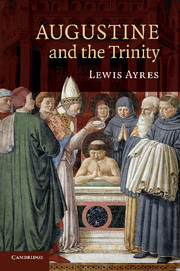Book contents
- Frontmatter
- Contents
- Acknowledgements
- List of abbreviations
- Introduction
- Part I Origins
- 1 Giving wings to Nicaea
- 2 From Him, through Him and in Him
- 3 Faith of our fathers:
- Part II Ascent
- Part III Into the mystery
- Part IV Memory, intellect and will
- Epilogue: Catching all three
- Bibliography
- Scripture index
- General index
- References
2 - From Him, through Him and in Him
Published online by Cambridge University Press: 06 December 2010
- Frontmatter
- Contents
- Acknowledgements
- List of abbreviations
- Introduction
- Part I Origins
- 1 Giving wings to Nicaea
- 2 From Him, through Him and in Him
- 3 Faith of our fathers:
- Part II Ascent
- Part III Into the mystery
- Part IV Memory, intellect and will
- Epilogue: Catching all three
- Bibliography
- Scripture index
- General index
- References
Summary
In summary: Everything A. wrote from his conversion in 386 down to but not including vera rel. on the threshold of ordination can be interpreted either as anti-Manichaean or pro-disciplina.
In this chapter, I explore Augustine's increasing knowledge of Latin pro-Nicene theology in the years between 388 and 391. Once again, my aim is not to offer a detailed history of Augustine's development, but to highlight the extent to which the fundamental principles and questions of his Trinitarian theology evolved through an idiosyncratic engagement with the Latin Nicene theologies of the 360–90 period. Augustine continues to bring together Nicene Trinitarian theology and themes from his readings in non-Christian Platonism, but he increasingly does so in the context of an anti-Manichaean polemic. In the 388–91 period Augustine's anti-Manichaean focus shapes fundamental aspects of the manner in which he describes the unified working of Father, Son and Spirit, and is the stimulus behind his discussion of how we may grow in understanding of God through the intelligible order of creation. This period of explicit anti-Manichaean Trinitarianism is thus of vital importance because it is in this context that we see Augustine developing themes central to his mature Trinitarian theology. I will begin, however, not with Augustine, but with his Latin predecessors. It is time to offer a more precise description of the Latin Nicene theology with which Augustine was familiar and in particular of the ways in which those theologians understood the inseparable operation of Father, Son and Spirit.
- Type
- Chapter
- Information
- Augustine and the Trinity , pp. 42 - 71Publisher: Cambridge University PressPrint publication year: 2010



